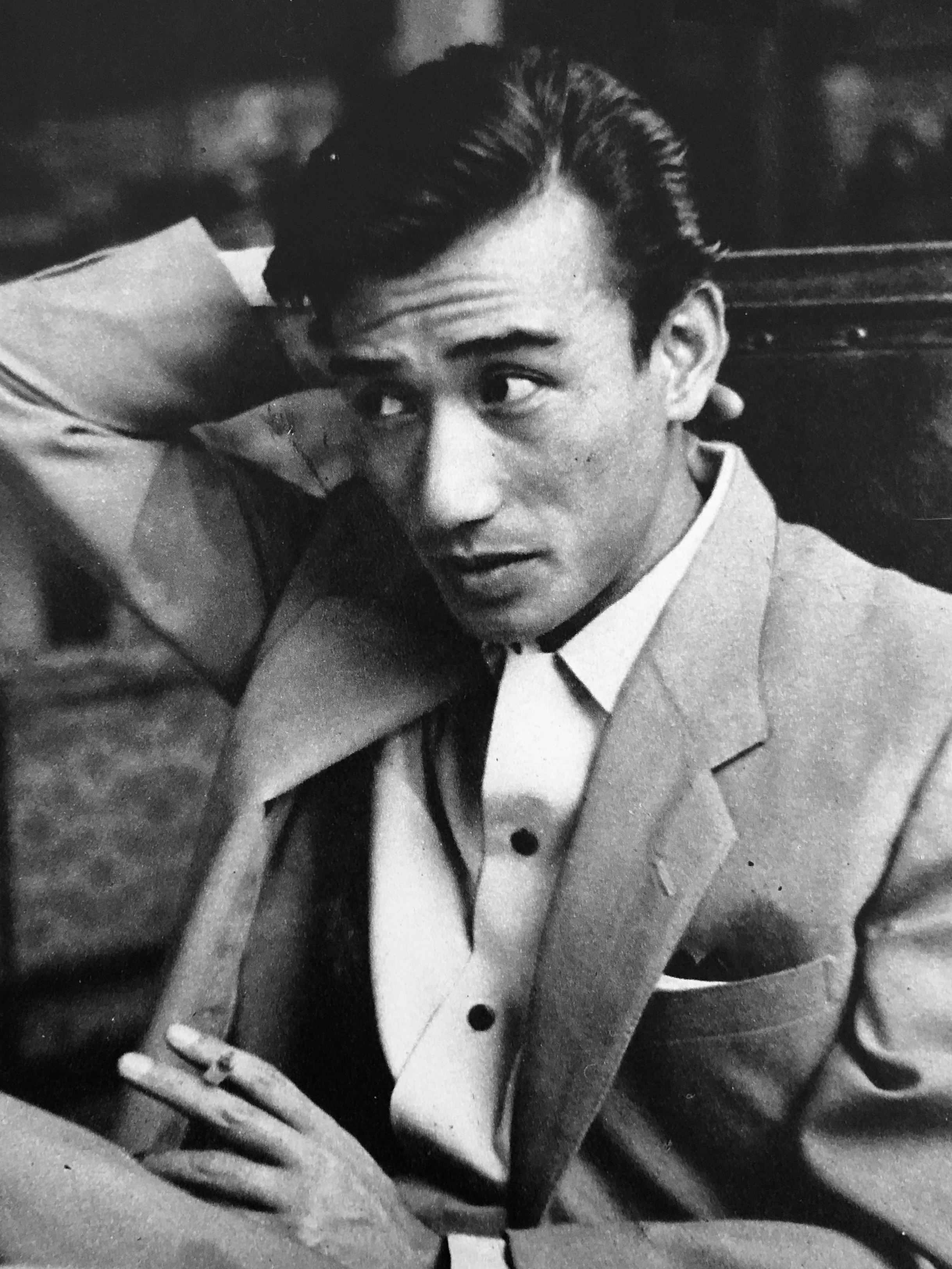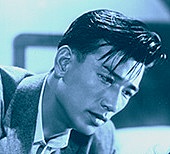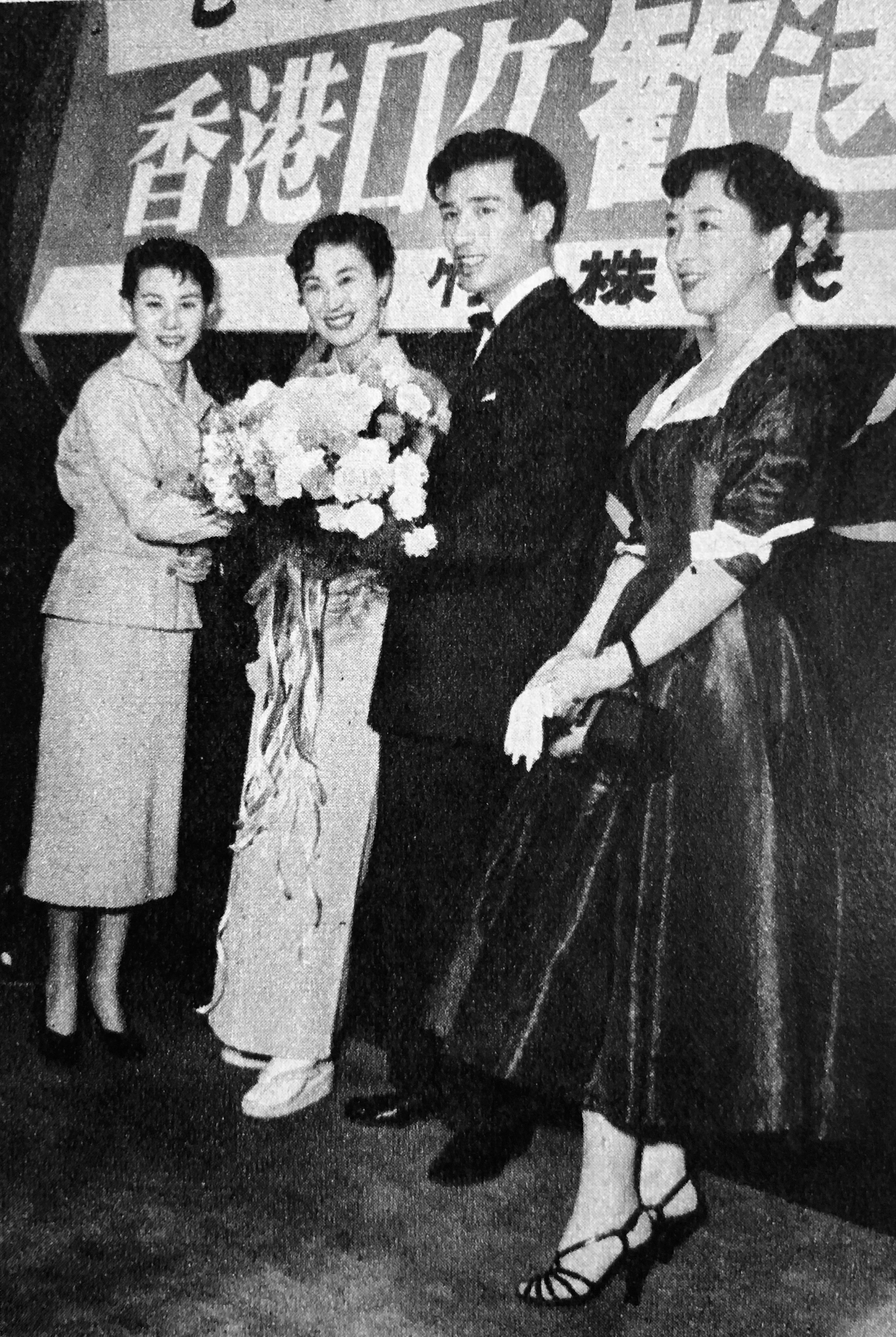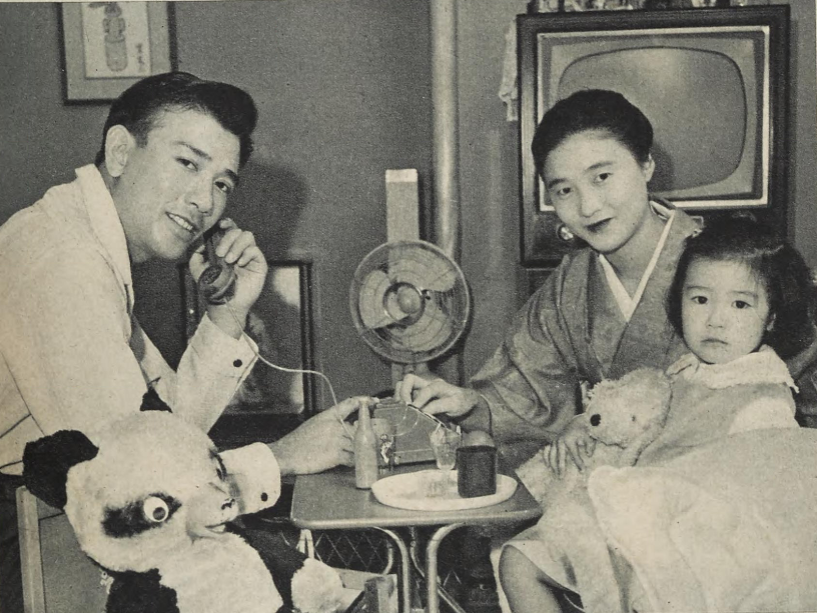1. Overview
Keiji Sada (佐田 啓二Sada KeijiJapanese, born Kanichi Nakai) was a highly prominent Japanese actor active from the late 1940s to the early 1960s. Born on December 9, 1926, in Kyoto, he became renowned for his versatility and significant contributions to post-war Japanese cinema. Discovered by director Keisuke Kinoshita, Sada quickly rose to stardom as one of the "Shochiku Post-war Three Crows," a group of popular young actors. He successfully transitioned from a handsome leading man to an acclaimed acting powerhouse, earning multiple Best Actor awards for his intense performance in Masaki Kobayashi's 1956 film I Will Buy You.
Sada was a favorite of celebrated directors such as Kinoshita and Yasujirō Ozu, appearing in many of their iconic films, including Ozu's An Autumn Afternoon. His prolific career spanned 151 films and several television dramas, notably including the NHK series Hana no Shōgai and the posthumously released Niji no Sekkei. Sada's life was tragically cut short at 37 due to a car accident on August 17, 1964. His enduring legacy is marked by his impactful filmography and the continued acting careers of his children, Kie Nakai and Kiichi Nakai.
2. Early Life and Education
Keiji Sada's early life in Kyoto laid the foundation for his eventual career in the Japanese film industry, marked by personal challenges and a determined pursuit of education before his entry into Shochiku Studios.
2.1. Birth and Childhood
Keiji Sada was born as Kanichi Nakai on December 9, 1926, in Shimogyō-ku, Kyoto. He was the second son of Keizo and Itoko Nakai, who belonged to a merchant family. He grew up with an older brother, five years his senior, and an older sister, two years his senior. His early years were marked by personal loss, as his mother passed away when he was in his third year of middle school, and his father died when he entered university. Despite these hardships, his older brother and and sister stepped in to support him, ensuring he could continue his education.
2.2. Education
Sada attended and graduated from the 2nd Kyoto Municipal Commercial School, which later became Kitano Junior High School. Following his graduation, he moved to Tokyo to pursue higher education, enrolling in the School of Political Science and Economics at Waseda University. During his university years, which coincided with wartime, he was mobilized for labor at the Toyokawa Naval Arsenal in Aichi Prefecture. He eventually graduated from Waseda University in 1947.
2.3. Entry into Shochiku and Stage Name
While studying in Tokyo, Sada resided in a boarding house owned by Shuji Sano, a popular actor at Shochiku Studios and the father of Hiroshi Sekiguchi. Sada's sister and Sano's wife were classmates in Kyoto, and his sister had asked Sano to allow her younger brother to work as a houseboy. Sano, initially hesitant about Sada pursuing an acting career, eventually introduced him to the studio director. Sada officially joined Shochiku Ofuna Studio on June 1, 1946. His stage name, Keiji Sada, was given to him by Shuji Sano, who generously lent characters from his own name to Sada.
3. Acting Career
Keiji Sada's acting career was characterized by a rapid ascent to stardom, a diverse range of notable film roles, and significant contributions to early Japanese television, solidifying his status as a leading figure in post-war Japanese cinema.

3.1. Debut and Rise to Stardom
After joining Shochiku, Sada was introduced to director Keisuke Kinoshita by Shuji Sano. In 1947, Sada made his debut in Kinoshita's film Phoenix (不死鳥FushichōJapanese), where he was immediately cast opposite the renowned star Kinuyo Tanaka in a love scene. This prominent role significantly boosted his career. Following his debut, he took on the lead role in Kane no Naru Oka (鐘の鳴る丘Kane no Naru OkaJapanese), a film adaptation of a popular NHK radio drama, which further cemented his popularity.
By 1948, Sada was still living with the Sano family, a household of eight that included Sano's wife, children, a maid, and Sada's sister. The Sano household was even featured in a national textbook for junior high school students. However, by 1952, Sada had moved into his own residence in Zaimokuza, Kamakura. He, along with Teiji Takahashi and Koji Tsuruta, became known as the "Shochiku Post-war Three Crows," a trio of highly popular young actors. His status as a top star was definitively established with the 1953 film Kimi no Na wa (君の名はKimi no Na waJapanese), an adaptation of another popular radio drama, in which he co-starred with Keiko Kishida. Throughout the 1950s, Sada maintained a prolific pace, starring in an average of eight to ten films annually.

3.2. Notable Film Roles
Keiji Sada's career saw him evolve from a "handsome leading man" to a highly respected "acting powerhouse." A pivotal moment in this transition was his role in Masaki Kobayashi's 1956 film I Will Buy You (あなた買いますAnata KaimasuJapanese). In this critical study of the institutional ethics of Japanese baseball, Sada delivered an intense performance as a ruthless talent scout who uses money to lure university students, showcasing his dramatic range opposite Yunosuke Ito. This role earned him several prestigious awards.
He continued to collaborate with acclaimed directors, appearing in Kinoshita's Times of Joy and Sorrow (喜びも悲しみも幾歳月Yorokobi mo Kanashimi mo IkutoshitsukiJapanese), where he played a lighthouse keeper alongside Hideko Takamine, depicting their lives from newlywed to old age. Sada also became a frequent collaborator with Yasujirō Ozu, appearing in four of his films: Equinox Flower (彼岸花HiganbanaJapanese, 1958), Good Morning (お早ようOhayōJapanese, 1959), Late Autumn (秋日和AkibiyoriJapanese, 1960), and An Autumn Afternoon (秋刀魚の味Sanma no AjiJapanese, 1962). He was initially offered a role in Ozu's 1953 masterpiece Tokyo Story, but had to decline due to scheduling conflicts with Kimi no Na wa. Later in his career, Sada diversified his roles, even taking on more complex and villainous characters.

3.3. Television Work
Beyond his extensive film career, Keiji Sada also made notable appearances in television dramas, broadening his appeal to a wider audience. In 1963, he played the role of Shuzen Nagano in Hana no Shōgai (花の生涯Hana no ShōgaiJapanese), an NHK Taiga Drama. His final television appearance was in the NHK drama Niji no Sekkei (虹の設計Niji no SekkeiJapanese), which aired from 1964 to 1966. In this series, he starred as the design engineer Keisuke Ichinohe. Following his untimely death, his character continued to appear in the drama through montage, with Goro Naya providing voiceovers for his remaining scenes.
4. Awards and Honors
Keiji Sada received numerous prestigious awards and accolades throughout his career, recognizing his exceptional acting achievements and significant contributions to Japanese cinema.
In 1956, he was honored with the Blue Ribbon Awards for Best Actor for his roles in both I Will Buy You and Taifū Sōdōki (台風騒動記Taifū SōdōkiJapanese). The same year, he also received the Mainichi Film Award for Best Actor for his performances in I Will Buy You and Taifū Sōdōki. Additionally, he was awarded the Kinema Junpo Award for Best Actor for his work in I Will Buy You. Posthumously, in 1964, he was recognized with a Special Award from the Mainichi Film Awards.
5. Personal Life
Keiji Sada's personal life, though often private, included a significant marriage, deep personal interests, and meaningful relationships with mentors and friends, all of which contributed to the multifaceted individual behind the celebrated actor.
5.1. Marriage and Family
On February 28, 1957, Keiji Sada married Masako Sugito, a woman who worked as a "signboard girl" at the "Tsukigase" restaurant located in front of Shochiku Ofuna Studio. Their marriage followed a decade-long courtship. After their wedding, they established their home in a newly built mansion in Den-en-chōfu, Tokyo. Their daughter, Kie Nakai, was born in November of the same year, and their son, Kiichi Nakai, was born in 1961. Kie Nakai later reflected on her parents' marriage, suggesting that her father chose her mother for her "homely and dependable" qualities. After Sada's tragic death, Masako Sugito courageously raised their two young children on her own, a testament to her strength, and she lived until 2016.

5.2. Personal Interests and Relationships
Known by his real name, Kanichi, among directors and co-stars who affectionately called him "Kan-chan," Keiji Sada was described by his university classmates as "serious, quiet, not laughing much, but very calm in observing things. He knew the world, was mature, yet somehow lonely." While admired for his serious demeanor as an actor, he was also known for his sharp tongue. His physical attributes included a height of 68 in (173.2 cm) and a weight of approximately 124 lb (56.25 kg). His foot size was about 10 in (25.5 cm).
Sada expressed a desire to drive cutting-edge automobiles and even contemplated finding a "romantic way to die" as a "lifetime desire." He enjoyed reading authors such as Tomoji Abe and Yuzo Yamamoto, and even continued to read Abe's Fuyu no Yado on the train after becoming an actor. His favorite actors were his mentor Shuji Sano and his frequent co-star Kinuyo Tanaka. He cherished solitude and had a passion for music, particularly jazz, enjoying slow and sweet swing music for hours. His favorite flowers included carnations, marguerites, and narcissus, while he disliked oysters, sea urchins, and sea cucumbers. He also expressed a dislike for rings and for women who were stubborn or conceited. He lived two houses away from the writer Izumi Kyō and notably took care of Teiji Takahashi's wife after Takahashi's untimely death.
His hobbies included photography, car driving (he owned several luxury cars throughout his life), and golf, which he took up after starting work. In his high school and university days, he was passionately involved in basketball. He maintained a friendship with sumo grand champion Chiyonoyama Masanobu, who was his contemporary and attended Sada's funeral in 1964.
- Relationship with Shuji Sano**: Shuji Sano, who played a pivotal role in Sada's entry into the film industry and gave him his stage name, initially opposed Sada's acting aspirations, believing that fame was ultimately a fleeting illusion. However, upon recognizing Sada's unwavering determination, Sano supported him, treating him like a younger brother and occasionally scolding him like a parent. Sano deeply mourned Sada's death, reflecting on their "more than real brotherhood" that spanned two decades and the transience of human fate. Sano expressed his sorrow that their reunion after six months was in death, and he lamented the loss of Sada, who had been planning to transition into a producer role to revitalize the film industry in response to the rise of television.
- Relationship with Keisuke Kinoshita and Yasujirō Ozu**: Both Keisuke Kinoshita and Yasujirō Ozu frequently cast Sada in their films, seeing him as an embodiment of the "post-war Japanese youth." Their close relationships extended to Sada's personal life, as both directors were close with his wife, Masako, and served as matchmakers at their wedding. Kinoshita was instrumental in discovering Sada early in his career, casting him in Phoenix and effectively launching him into stardom. Sada appeared in four of Ozu's films: Equinox Flower, Good Morning, Late Autumn, and An Autumn Afternoon. He was offered a role in Ozu's 1953 film Tokyo Story but had to decline due to scheduling conflicts with Kimi no Na wa. Sada deeply admired Ozu, considering him a father figure. He reportedly nursed Ozu in Kamakura and was said to have wept like a child at Ozu's funeral.
6. Death
Keiji Sada's life ended tragically and unexpectedly in a car accident, a loss that deeply affected the Japanese film industry and his many fans.
6.1. The Fatal Accident
On August 17, 1964, Keiji Sada was returning to Tokyo from his summer villa in the Tateshina Mountains of Nagano Prefecture, where he had been vacationing with his family since August 13. The villa itself had only been completed that year. Around 6:30 AM, as his chauffeur attempted to overtake another vehicle on a left curve just before the Shiokawa Bridge in Nirasaki, Yamanashi Prefecture, the car skidded. The right side of the vehicle, where Sada was seated, violently collided with a bridge pillar. The car then bounced off the pillar and struck the vehicle it had just overtaken, resulting in a major accident.
Sada suffered a fractured skull and a broken right arm. He was immediately transported to Nirasaki Municipal Hospital but succumbed to his injuries around 11:00 AM, at the age of 37. At the time of the tragedy, his daughter, Kie, was 7 years old, and his son, Kiichi, was 2 and a half. While his wife and two children, who were also in the car, were fortunately unhurt, others sustained injuries: the chauffeur suffered serious head injuries requiring two months for recovery, Shinji Doi, a reporter for Nikkan Sports and a friend of Sada, sustained a facial bone fracture that took a month to heal, and Sada's brother-in-law had a minor right shoulder injury that healed in a week. Years later, in a 2022 television interview, his son Kiichi Nakai revealed that the accident was caused by the driver falling asleep at the wheel.
6.2. Funeral and Public Reaction
Keiji Sada's funeral was held on August 22, 1964, at 2:00 PM, at the Aoyama Funeral Hall in Tokyo. The ceremony was attended by nearly a thousand people, including numerous figures from the entertainment industry and a large number of his devoted fans, reflecting the widespread shock and grief over his untimely passing. His grave is located at Matsurei-in, a sub-temple of Engaku-ji in Kamakura.
7. Legacy and Critical Evaluation
Keiji Sada left an indelible mark on Japanese cinema, remembered for his artistic evolution and the enduring influence he had on his family's artistic pursuits.
7.1. Artistic Contributions and Critical Reception
Throughout his career, Keiji Sada appeared in a remarkable 151 films, showcasing his versatility and dedication to his craft. His final work was the NHK drama Niji no Sekkei, where he played the lead role of design engineer Keisuke Ichinohe. Following his death, his character continued to be featured in the drama through montage, with Goro Naya providing voiceovers for his remaining scenes, allowing his presence to continue beyond his passing.
Sada was widely praised for his transformation from a conventional "handsome leading man" to a highly skilled "acting powerhouse." His intense and nuanced performance in I Will Buy You is often cited as a prime example of his dramatic capabilities. His collaborations with visionary directors like Keisuke Kinoshita and Yasujirō Ozu were instrumental in shaping post-war Japanese cinema, with Sada often embodying the archetype of the "post-war Japanese youth." Over time, he expanded his repertoire to include more complex and even villainous characters, demonstrating his range and commitment to artistic growth.
7.2. Family Legacy
Keiji Sada's artistic legacy continues through his children, Kie Nakai and Kiichi Nakai, both of whom have become successful actors in their own right, carrying on their father's artistic lineage in the entertainment industry. Kie Nakai has publicly commended her mother, Masako Sugito, for her strength in raising her and her brother alone after their father's death, notably without blaming the driver for the accident.
The children also share an appreciation for their father's filmography. Kie Nakai considers I Will Buy You to be her favorite of his films, believing it highlighted his "acting skill" beyond his "handsome" image. Kiichi Nakai's favorite is Ozu's Good Morning, admiring his father's unpretentious and natural acting style. Both children collectively chose Kono Hiroi Sora no Dokoka ni (この広い空のどこかにKono Hiroi Sora no Dokoka niJapanese) as a film that, to them, best revealed their father's true self, Kanichi Nakai.
7.3. Criticisms and Controversies
There are no significant criticisms or controversies widely associated with Keiji Sada's career or personal life in the available historical records.
8. Filmography
Keiji Sada had a prolific career in both film and television, appearing in a wide array of productions during his active years.
8.1. Films
- Phoenix (1947) - Shinichi Yasaka
- Akai kuchibiru imada kiezu (1947)
- Shozo (1948)
- Hi no bara (1948)
- Kane no naru oka - Dai ippen: Ryūta no maki (1948) - Shūhei Kagami
- Kane no naru oka - Dai nihen: Shukichi no maki (1949) - Shūhei Kagami
- Ojōsan kanpai! (1949) - Gorō
- Beni imada kiezu (1949)
- Yotsuya kaidan (1949) - Kohei Kobotoke
- Shinshaku Yotsuya kaidan: kōhen (1949) - Kohei Kobotake
- Mahiru no embukyoku (1949) - Hidetaka
- Kane no naru oka: Dai san hen, kuro no maki (1949) - Shūhei Kagami
- Kikenna ninrei (1950)
- Nanatsu no hōseki (1950)
- Oboro kago (1950) - Junnosuke Koyanagi
- Carmen Comes Home (1951) - Mr. Ogawa, the young school master (first color film appearance)
- Home Sweet Home (1951) - Saburo Uchiyama, Tomoko's boyfriend
- Jiyū gakkō (1951)
- Tenshi mo yume o miru (1951)
- Yume ōki koro (1951) - Shūji Takaishi
- Fireworks Over the Sea (1951) - Tamihiko Kujirai
- Inochi uruwashi (1951) - Shuji Imura
- Honjitsu kyūshin (1952) - Haruzo Yukawa
- Hibari no Circus kanashiki kobato (1952)
- Uzushio (1952) - Kenji
- A Japanese Tragedy (1953) - Tatsuya, street musician
- Tabiji (1953) - Ryosuke Tsugawa
- Kimi no Na wa Part 1 (1953) - Haruki Kōmiya
- Kimi no Na wa Part 2 (1953) - Haruki Kōmiya
- Ojōsan Shachō (1953) - Goro Akiyama
- Yassamossa (1953) - Tasuke Akamatsu
- Shinjitsu ichiro (1954) - Mr. Yazu
- Kunsho (1954) - Kenji
- Kimi no Na wa Part 3 (1954) - Haruki Kōmiya
- Kono hiroi sora no dokoka ni (1954) - Ryoichi Morita
- Seishun no oto (1954) - Masaaki Sugimoto
- Bomeiki (1955) - Akimasa
- Uruwashiki saigetsu (1955) - Nakao
- Tōkyō-Honkon mitsugetsu ryokō (1955) - Shunsuke Yamashita
- Tooi kumo (1955) - Shunsuke, Fuyuko's brother-in-law
- Kakubō sambagarasu (1956) - (uncredited)
- Izumi (1956) - Akitaro Ikushima
- I Will Buy You (1956) - Daisuke Kishimoto
- Taifū Sōdōki (1956) - Koichi Yoshinari
- Onna no ashi ato (1956) - Koichi Hamada
- Namida (1956) - Shinya Yamazaki
- Seigiha (1957) - Fujita
- Doshaburi (1957) - Kazuo Sudō
- Xiang Gang Dong Jing mi yue lu xing (1957)
- Tadaima zero hiki (1957) - Yoshizawa, Diet member
- Times of Joy and Sorrow (1957) - Shiro Arisawa, Kiyoko's husband
- Shukin ryoko (1957) - Ryōhei Hata
- Danger Stalks Near (1957) - Kaneshige Satō
- Kuroi kafun (1958) - Takashi Kiso
- Onboro jinsei (1958) - Mr. Shiketa
- Hibi no haishin (1958) - Hiroyuki Doi
- Kamitsukareta kaoyaku (1958) - Izumikawa
- Equinox Flower (1958) - Masahiko Taniguchi
- Me no kabe (1958) - Tatsuo Hagisaki
- Haru o matsu hitobito (1959) - Yōgaka Nishiwaki
- The Human Condition Part 1 & 2 (1959) - Lieutenant Kageyama
- Sekishunchō (1959) - Eitarō Makita
- Good Morning (1959) - Heiichirō Fukui
- High Teen (1959) - Shin'ichi Teras'aki
- The Human Condition Part 3 & 4 (1959) - Lieutenant Kageyama
- Yonman-nin no mokugekisha (1960) - Masashi Takayama
- Irohanihoheto (1960) - Ryuichi Amano
- Onna no saka (1960) - Saburo Yaoi
- Blood Is Dry (1960) - Takashi Kiguchi
- Late Autumn (1960) - Shotaru Goto
- Saigo no kiri fudâ (1960) - Shunsuke Tateno
- Enraptured (1961) - Shōzō Nishikawa
- Kumo ga chigireru toki (1961) - Misaki
- Immortal Love (1961) - Takashi Kawaminami
- Tsuma ari ko ari tomo arite (1961)
- Uzu (1961) - Kosuke Nakatsu
- Hunting Rifle (1961) - Reijiro Kadota
- Kyōgeshō (1961) - Yamaoka
- Senkyaku banrai (1962) - Ryosuke Bandori
- Aizen Katsura (1962) - Hattori
- Kaasan nagaiki shitene (1962) - Oshima
- Zoku aizen katsura (1962) - Hattori
- An Autumn Afternoon (1962) - Koichi Hirayama
- Futari de aruita iku haru aki (1962) - Yoshio Nonaka, Torae's husband
- Utae Wakōdotachi (1963) - Singer at the ceremony
- Mushukunin-betsuchō (1963) - Yajuro Munakata
- Kaze no shisen (1963) - Shunsuke Kuze
- Kekkonshiki Kekkonshiki (1963) - Jirō Okuyama
- Odoritai yoru (1963) - Tadao Tsumura
- Zoku Haikei Tenno Heika Sama (1964) - Ryosuke Kurumiya
- Assassination (1964) - Sakamoto Ryōma
- Aku no monsho (1964) - Shigeharu Takazawa
- Sweet Sweat (1964) - Tatsuoka
- Monro no youna onna (1964) - Shizuo Minaguchi (final film role)
8.2. Television Dramas
- Tenraku no Shishū (1959, NET)
- Hana no Shōgai (1963, NHK) - Shuzen Nagano
- Seishun Hōkago (1963, NHK) - Ichiro Hasegawa
- Toshiba Nichiyō Gekijō / Aisuru (1963, TBS)
- Kintetsu Kin'yō Gekijō Taiyō o Sagase (1964, TBS) (aired as a memorial program)
- Niji no Sekkei (1964-1966, NHK) - Keisuke Ichinohe (posthumous work)